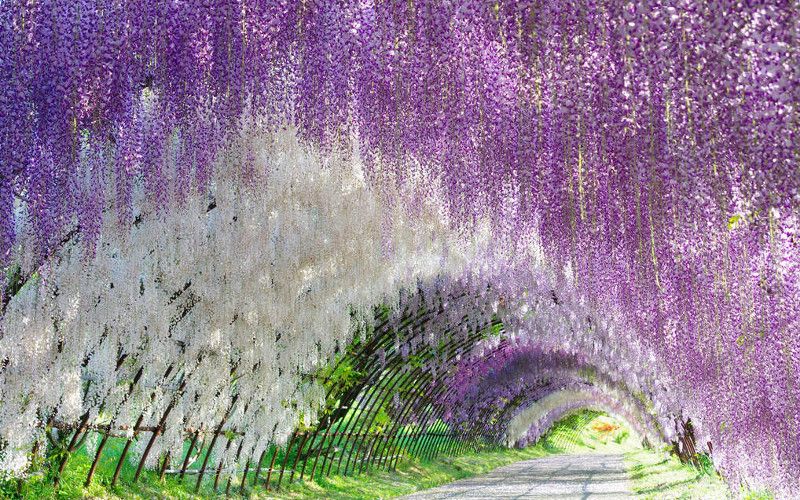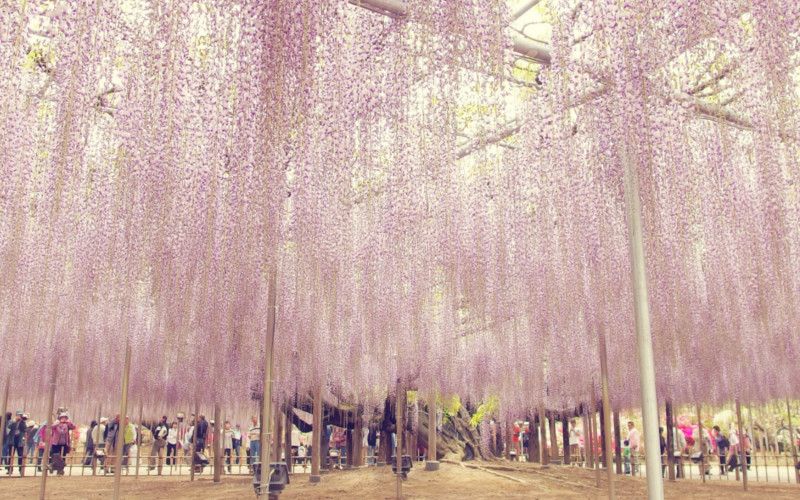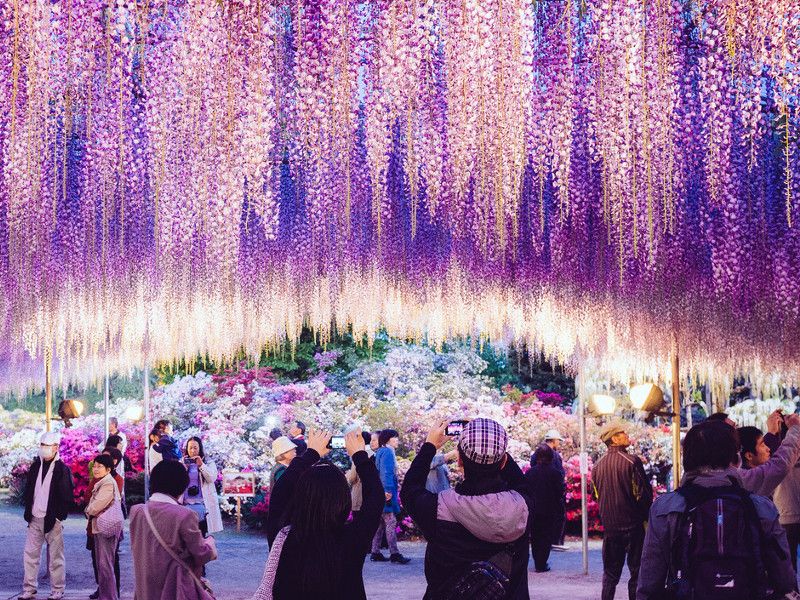The Ashikaga Flower Park first opened in 1968 and now spans 94,000 square meters (23 acres) of land approximately 74 kilometers north of Tokyo. The park is famous across Japan for housing a 150-year-old wisteria tree which has been designated as a national monument by the Tochigi Prefecture.
In addition to this amazing natural wonder, you can experience an 80-meter tunnel of white wisteria or yellow Kibana, thousands of azaleas, hundreds of other flowers, and winter lights. The flowers themselves are also illuminated at night, providing a truly otherworldly experience.
Table of Contents
How to Get to Ashikaga Flower Park from Tokyo
You can use your Japan Rail pass to easily reach the Ashikaga Flower Park from Tokyo. There are several ways to get to Ashikaga Flower Park Station, but you must first arrive at Oyama Station to take the JR Ryomo line.
The fastest way is taking the Shinkansen (41 minutes from Tokyo Station). Some Shinkansen om Tohoku Shinkansen line stops at Oyama Station. Alternatively, you can also use the JR Utsunomiya line (1 hour and 10 minutes from Tokyo Station).
Once in Oyama Station, transfer to the JR Ryomo Line to Ashikaga Flower Park Station (34 minutes). The park is a three-minute walk from the station, located at 607 Hasamacho, Ashikaga.
Opening Hours and Entrance Fee
For most of the year, the Ashikaga Flower Park opens at 9 am and closes at 6 pm. On Saturdays, Sundays and on national holidays for “the Garden of Illuminated Flowers”, the park is open untel 9 pm.
During the winter, from late November until February, hours are reduced, from 10 am to 5 pm.
Extended hours, from 7 am until 9 pm, can be enjoyed during the Wisteria Festival period (mid-April to mid-May).
The park is open year-round, closed only on December 31 and the third Wednesday and Thursday of February.
Depending on the time of year and the type of ticket purchased, adult admission fees range from 300 to 1800 yen. Prices are highest during the peak flower season, during the months of April and May. Lower prices can be enjoyed from July until February. For children, fees range from 100 to 900 yen. Children under the age of four are admitted free of charge.
The Wisteria Tunnel
Wisteria is called fuji in Japanese. Like the mountain that bears a similar name, this flower is much beloved by the Japanese people. A relative of the pea, this ornamental vine can be trained to grow into fabulous shapes. Two 80 meter tunnels grace the park, one of white wisteria and the other of the the wisteria-like yellow Kibana.

What Is the Best Time to Visit Ashikaga Flower Park?
From a botanical point of view, a year in Japan can be divided into eight floral seasons, or chapters. These include:
- Heralding Spring, from early January to late February.
- The Spring Flower Festival, from early March to mid-April.
- Wisteria Story, from mid-April to mid-May.
- Rainbow Garden, from mid-May to early June.
- Blue and White Garden, from early June to early July.
- Water Nymphs, from early July to late September.
- Purple Garden, from early October to late November.
- Bejeweled Flower Garden, late October to late January.
Each of these stages has its own beauty and charm. Hundreds of trees and flowering plants are involved in each chapter – even in the cold of winter. While many visitors choose mid-April to mid-May in order to view the famed wisteria, the park has plenty to offer all year round.
Great Wisteria Festival
In Ashikaga Flower Park, you can witness more than 350 wisteria trees in full bloom. These trees bloom in stages – first the pale red, then the purple, white, and yellow, allowing visitors to have different experiences throughout the festival.

Every year, the Great Wisteria Festival is held depending on flowering, from early April to mid-May. During the Great Wisteria Festival, the park typically opens at 7.00 am and closes at 6.00 pm. The Light up period also has special nighttime admission openning hours, from 5:30 pm to 09:00 pm.
The latest adult admission fees range from 900 to 1800 yen, and for children from 500 to 900 yen, depending on when de flowers bloom. During the Light up period, the adult night admission fees range from 600 to 500 yen, and for children from 300 to 800 yean.
Flower Fantasy: Ashikaga Flower Park Winter Illumination
In winter, fewer flowers bloom, but they are there – flowers such as pansies and violas. These are supplemented, however, with enthralling winter illumination displays. Almost every inch of the park becomes a light flower garden, courtesy of 4.5 million multi-colored LED lights. Strands of lights resembling fuji flowers hang from trellises. Lights cover the bushes and trees and line the walkways. Light shows and LED screens are synchronized to music to create a dreamlike escape.

The Garden of Illuminated Flowers has won Japan’s Illumination Award for three consecutive years, and it is one of the top three illumination events in Japan. Check out our article Best Japan Winter Illuminations for more illuminated events around Japan.
If you like the Ashikaga Flower Park, be sure to check out Japan’s other wisteria tunnels, including Kawachi Fuji Gardens in Kitakyushu. This white and purple striped wisteria tunnel is created using about 150 wisteria plants of 20 different species.
